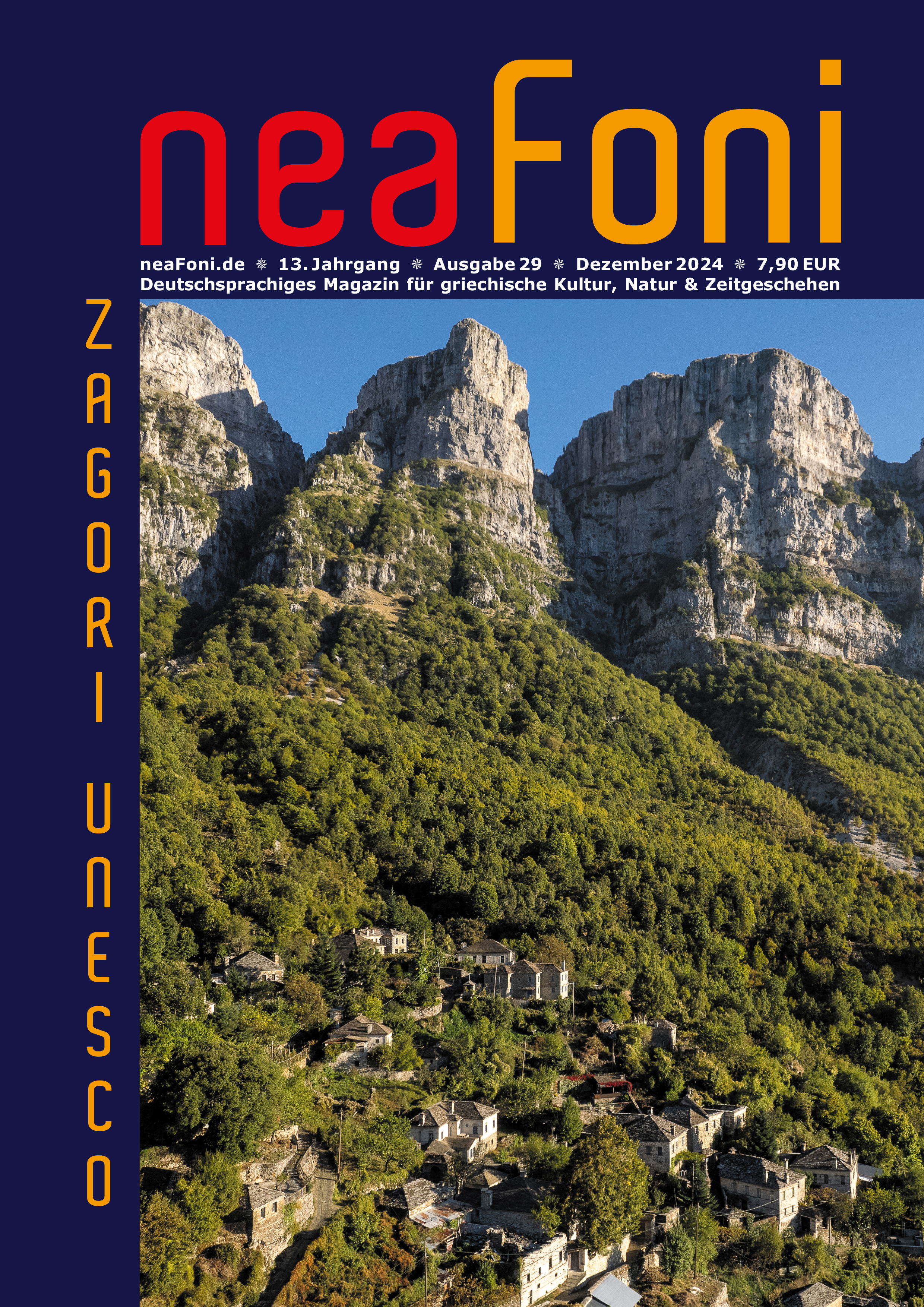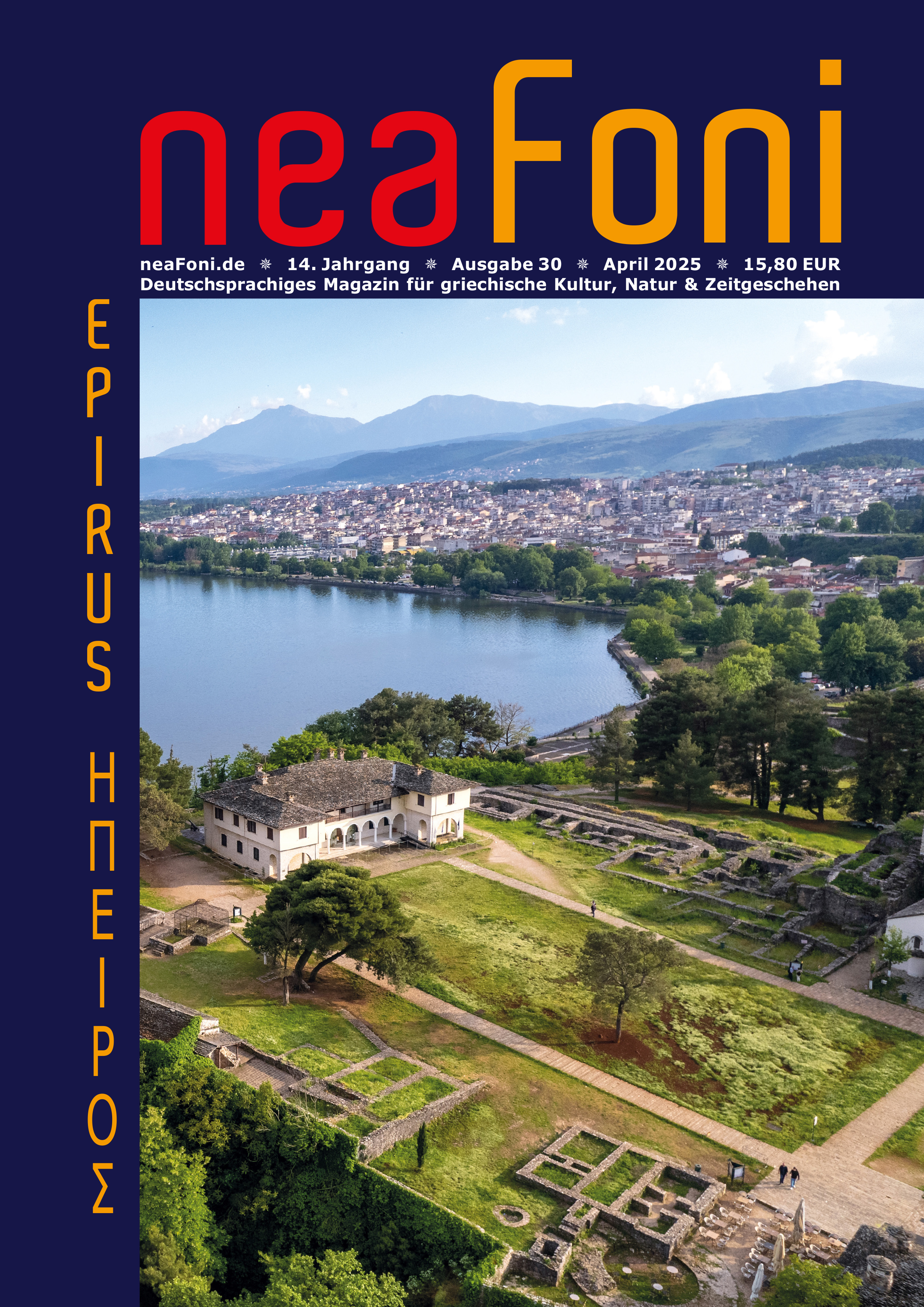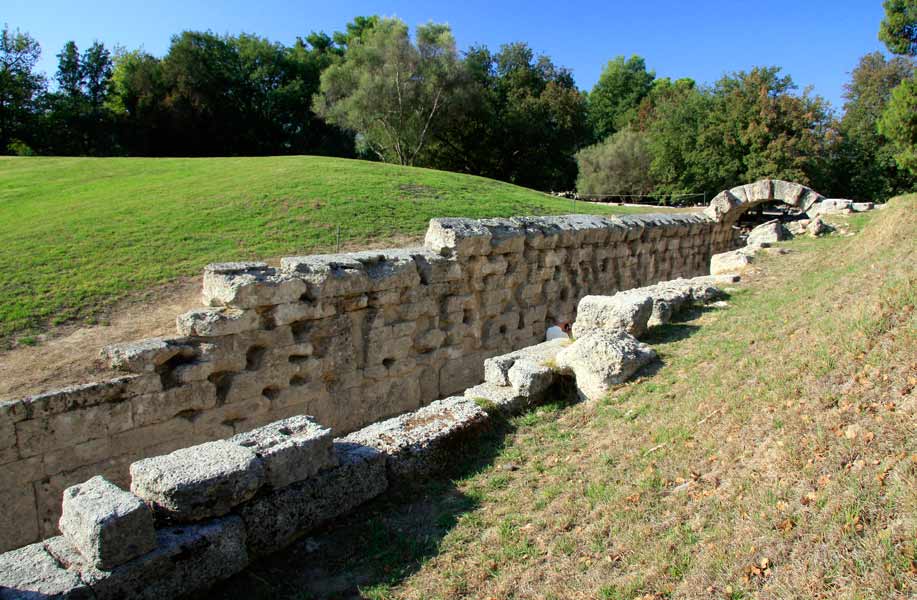Die archäologischen Grabungen in Olympia fördern nicht nur neue Funde zutage sondern auch faszinierende neue Erkenntnisse über die Geschichte dieses Heiligtums. Im Norden und Osten eingerahmt von Bergen und Hügeln, schaffen die Flüsse Alpheios und Kladeos im fruchtbaren Tal bei Olympia eine für Griechenland eher untypische, anmutige Landschaft. In der Mitte des Tales erhebt sich der seit Urzeiten heilige, von Kiefern bewachsene Kronoshügel, wo Kronos und Rhea angeblich schon vor der Geburt von Zeus geopfert wurde, an seinem Fuß wurde die Erdgöttin Gaia verehrt. Dass die menschlichen Spuren an diesem Ort tatsächlich uralt sind, haben die neueren archäologischen Forschungen inzwischen zweifelsfrei belegt. Keramikfunde werden auf das Frühhelladikum (2500 - 1900 v.Chr.) datiert. Ein frühhelladisches (ca. 2100 v.Chr.) Apsidenhaus kann heute im Grabungsgelände besichtigt werden. Noch älter, aber auch aus der Zeit des Frühhelladikums ist auch der Tumulus, der sich unter dem Hügel des Pelops (Pelopion) verbirgt. Dieser etwa 2600 - 2500 v.Chr. erbaute Tumulus ist nicht nur das bisher älteste bekannte Bauwerk von Olympia, sondern auch der bisher älteste bronzezeitliche Tumulus des gesamten helladischen Raumes. Die Vermutung, dass es sich um ein Grab handeln könnte haben sich nicht bestätigt, da keine Spuren einer Grablegung gefunden wurden. Deshalb geht man davon aus, dass es sich um einen „Ritual-Tumulus“ gehandelt haben könnte. Brand- und Aschestellen waren im Tumulus allerdings ebenso wenig zu finden wie Reste von Tierknochen. Dafür gab es jedoch Muscheln und Gehäuse von Weinbergschnecken in großen Mengen. Da in dieser Zeit Schnecken als Nahrung dienten, wäre es vorstellbar, dass in dem Tumulus kultische Feiern abgehalten wurden, bei denen die Schnecken und auch Muscheln den Göttern als Opfer dargebracht und später verzehrt wurden. Die Feiern müssen zu einer Jahreszeit stattgefunden haben, in der es Schnecken gibt, also im Frühjahr oder Herbst. Die Schnecken mit ihren im Erdreich heranreifenden zahlreichen Jungen könnten als ein Symbol für die Fruchtbarkeit und für das Wiedererwachen der Natur betrachtet worden sein. Möglicherweise besteht hier ein Zusammenhang mit der Verehrung von weiblichen Gottheiten wie Ge, Themis, Eileithyia und Aphrodite Urania mit ihrem mütterlich-fruchtspendenden und chthonischen Charakter. Diese Gottheiten gelten als vorgriechisch, sind von antiken Schriftstellern aber belegt. Der Ort wurde dann von seinen Bewohnern verlassen, sei es wegen Überschwemmungen oder durch das Eindringen von anderen Völkern.
Nachgewiesen ist dann eine mykenische Siedlung aus der ersten Hälfte des 2. Jt. v.Chr., beherrscht wurde der Heilige Bezirk in dieser Zeit von dem Königssitz Pisa. Ein Teil des Tumulus muss damals noch sichtbar gewesen sein. Die Funde zeigen, dass hier auch in spätmykenischer Zeit Opferhandlungen vollzogen wurden. Wie an anderen Orten auch wurden die ehrwürdigen Reste der alten Heiligtümer für die eigenen Kulthandlungen einfach „weiterbenutzt“. Die Verehrung des Zeus begann in Olympia jedoch erst zu Beginn des 1.Jt.v.Chr., wahrscheinlich eingeführt durch die Dorer, die in dieser Zeit auf die Peloponnes einwanderten. Vielleicht war zur Zeit Pindars (ca. 520 - 446 v.Chr.) noch eine ferne Erinnerung an die Vorgeschichte des Heiligtums vorhanden, da er beschreibt, dass Herakles beim „alten Male des Pelops“ ein Heiligtum des Zeus gegründet habe (Ol.X,24f). Zu Ehren des olympischen Zeus wurde der Ort dann auch Olympia genannt. Ob bereits zu diesem Zeitpunkt athletische Wettkämpfe durchgeführt wurden ist nicht belegt. Zunächst wurde Zeus in seinem von Platanen und wilden Ölbäumen bewachsenen heiligen Hain, der Altis (= Wäldchen oder Hain) als Orakel- und Kriegsgott verehrt, worauf auch die zahlreichen gefundenen Votivgaben weisen. Im Zentrum der rituellen Handlungen stand noch kein Tempel sondern der Aschenalter, an dem die Tieropfer (vor allem Rinder) vollzogen wurden. Die Kultstätte hatte zunächst eine vorwiegend lokale Bedeutung für Aristokratie, Bauern und Viehzüchter aus der Region.
Ein Grund für die Einführung der athletischen Wettkämpfe könnte in der Sage des Pelops zu finden sein. Das Pelopion über dem oben erwähnten Tumulus in der Altis von Olympia wurde als nämlich sein Grab betrachtet und es ist denkbar, dass es zu Ehren des Helden abgehaltene religiöse Leichenspiele im Rahmen des alten Totenkultes waren (Homer beschreibt in der Ilias, wie beim Tod des Patroklos solche Spiele veranstaltet wurden), die am Anfang der Olympischen Spiele standen.
Der religiöse Charakter der Spiele deutet darauf hin, dass man die Wettläufe nicht im sportlichen Sinn wie heute verstand - in unserer Zeit käme ja niemand auf die Idee, bei einem Begräbnis Wettrennen zu veranstalten. Es ging eher um die Suche des griechischen Menschen nach dem Göttlichen, denn „in Sieg und Niederlage äußern sich Gunst und Mißgunst der Götter. Der Wettkampf ist die Probe für die Gottgeliebtheit des Menschen“ (Mannsperger). Der Sieg war also ein Beweis, das man von den Göttern geliebt wurde und das sichtbare Zeichen, ein Freund der Götter zu sein, war der Zweig vom heiligen Ölbaum des Zeus, mit dem der Sieger bekränzt wurde. Im Jahr 776 v.Chr. wurde zum ersten Mal der Name des Siegers schriftlich aufgezeichnet. Dieses Jahr ist das älteste sichere Datum der griechischen Geschichte. Für die Griechen selbst wurden die „Olympiaden“ später übrigens zur gängigen Zeitrechnung für alle Ereignisse, die von überregionaler Bedeutung waren.
Der älteste und zunächst einzige Wettkampf war der einfache Wettlauf (600 Fuß = 191,27m) zum heiligen Ölbaum, der an einem Tag ausgetragen werden konnte. Später kamen der Doppellauf (über die doppelte Strecke), der Dauerlauf, der Ringkampf und der Fünfkampf ( Laufen, Weitsprung, Diskuswurf, Speerwurf und Ringen) dazu. Wagenrennen (Anf. 7.Jh.) und Waffenlauf (6.Jh.), Wettkämpfe für Knaben und Jünglinge erweiterten den Umfang der Spiele schließlich so enorm, dass sich das Fest später über sechs Tage hinzog.
Teilnehmen konnten alle Griechen von freier Geburt, die frei von Gottesfrevel und Blutschuld waren. Frauen durften nicht teilnehmen, dafür gab es aber Wettläufe ausschließlich für Frauen, die ebenfalls alle vier Jahre im Sommer ausgetragen wurden und zwar jeweils in der Mitte des Zeitraumes zwischen den Olympiaden. Als Zuschauerinnen waren Mädchen und unverheiratete Frauen auch bei den „Männerolympiaden“ zugelassen, verheiratete Frauen jedoch nicht.
Die Olympischen Spiele gewannen zusehends an Bedeutung. Die Siegerliste nennt nicht mehr nur regionale Namen, schon im 7.Jh. kommen mehr und mehr Teilnehmer auch aus Sparta, Athen, Theben, Smyrna, und den griechischen Kolonien in Sizilien und Unteritalien angereist. Die Olympischen Spiele haben sich zu der panhellenischen Veranstaltung schlechthin entwickelt. Die gesamte griechische Welt trifft sich zu den Spielen und die Ehre eines Sieges ist nicht nur für die Sieger sondern auch für seinen Herkunftsort, seine Polis, von unschätzbarer Bedeutung. Eine wichtige Rolle spielten die Olympischen Spiele sicher auch bei der Entwicklung der Gesellschaftsstrukturen, denn früher waren die Ideale der Tugend und Tüchtigkeit nur den wenigen vorbehalten, die im politischen Leben und im Krieg zählten, das heißt, der Aristokratie. Nun war das Ideal der Tugend, sowohl körperlich wie geistig, ein von jedem freien Bürger angestrebtes Ziel geworden. Die Laufbahn ragte zu dieser Zeit noch bis weit in die Altis hinein, der Platz der Wettkämpfe war bestimmt durch die Lage des Zeusaltars und des Pelopions, zu deren Ehre die Wettkämpfe stattfanden und die man als anwesend erlebte.
Der glanzvollste Höhepunkt der Olympischen Spiele in der Antike dürfte sicher die erste Olympiade nach dem großen Sieg über die Perser gewesen sein, die im Jahr 476 v.Chr., unter der Leitung der neu gegründeten Landeshauptstadt Elis stattfand. Es war eine einzige Pracht- und Jubelfeier des neuen griechischen Nationalbewußtseins, bei der auch Themistokles, der siegreiche General der Schlachten von Plataia und Salamis auftrat. In diesem Jahr 476 v.Chr. wurden die Siegerlisten 300 Jahre, d.h. 75 Olympiaden zurück gerechnet und das berühmte Gründungsdatum von 776 v.Chr. ermittelt. Bald darauf, von 470 - 456 v.Chr., wurde der herrliche Zeus-Tempel errichtet, dessen monumentale Zeusstatue von Phidias zu einem der sieben Weltwunder gezählt wurde. Doch wie in so vielen anderen Fällen auch, folgt auf die Blüte der Niedergang und der ließ auch in Olympia nicht auf sich warten, auch wenn das manche Idealisten vor allem in der Zeit der Philhellenen nicht wahrhaben wollten in ihrer Verehrung für die antike griechische Kultur. Ein Sieg in Olympia war so bedeutend, dass dafür alles getan wurde und so begann sich allmählich das Berufsathletentum zu entwickeln. Die Aristokraten und reicheren Bürger nahmen nicht mehr selbst an den Spielen teil, sie ließen die bezahlten und hoch spezialisierten Athleten für sich laufen oder kämpfen. Der Sieg war wichtiger geworden als die Tugend. Das zeigt sich unter anderem darin, das im 4.Jh. v.Chr. zahllose Bronzestatuen des Zeus von den Strafgeldern hergestellt wurden, die Athleten bezahlen mussten, wenn sie gegen die Spielregeln verstoßen hatten, indem sie beispielsweise ihre Gegner bestachen. Wer würde da nicht an die „heiligen Eide“ denken, die von unseren heutigen Athleten geschworen werden, während sie schon voll von Dopingmitteln sind.
All diesen Dekadenzerscheinungen zum Trotz wurde jedoch die heilige Waffenruhe, die Ekecheiria über Jahrhunderte eingehalten. Wie erbittert man sich auch bekämpfte, zur Zeit der Olympischen Spiele wurden die Waffen niedergelegt und es herrschte Friede. Es dürfte nicht viele Beispiele geben, wo eine vergleichbare Konvention sich so lange gehalten hätte. In der über tausendjährigen Geschichte der Olympischen Spiele wurde diese heilige Waffenruhe nur zwei Mal verletzt, 420 v.Chr., während des Peloponnesischen Kriegs (431 - 404 v.Chr.), von den Spartanern, die daraufhin von den Spielen ausgeschlossen wurden, und 362 v.Chr., als Pisaten und Arkadier sich vor dem versammelten Publikum verprügelten.
Die Spiele entwickelten sich zu einem Publikumsmagneten, wobei das Publikum sich bald nicht mehr damit begnügte, auf der Erde zu kampieren und sich luxuriöse Unterkünfte erstellen ließ wie das Leonidaion (4.Jh.). Der veränderten Zeitgeist zeigt sich auch darin, dass der Makedonenkönig Philipp II. nach der Schlacht von Chaironeia (338 v.Chr.) in der Altis von Olympia, wo bisher nur Götter und Heroen einen Platz neben Zeus einnehmen durften, durch den Bau des Phillipeions ein Denkmal zur Verehrung der makedonischen Königsfamilie schuf. Die religiösen Zeremonien wurden zwar weiter gefeiert, waren aber nicht mehr das Zentrum, sondern eher schmückendes Beiwerk der Spiele. Die Olympischen Spiele waren dennoch von solcher Bedeutung, dass sie selbst in der römischen Kaiserzeit noch lange gefeiert wurden. Im Jahr 393 n.Chr. zog dann schließlich der byzantinische Kaiser Theodosius den Schlußstrich, indem er die Spiele verbot. Eine frühchristliche Siedlung bestand zu dem verheerenden Erdbeben, das im Jahr 522 in weiten Teilen des östlichen Mittelmeers und auch auf der Peloponnes große Schäden anrichtete. Auch Teile des Zeus-Tempels stürzten ein. Ein weiteres Erdbeben verursachte im Jahr 551 den endgültigen Einsturz des Tempels. Das Dorf wurde danach etwas verändert wieder aufgebaut, dann aber fluchtartig verlassen, als in den achtziger Jahren des 6. Jh. die Avaren und mit ihnen verbündete Slawen plündernd und mordend durch die ganze Peloponnes zogen. Nach Jahren der Verödung zogen einige wenige Bewohner in die bereits verfallenen Häuser und fristeten ein kärgliches Dasein, bis eine Überschwemmung des Kladeos auch sie vertrieb. Auch der heilige Bezirk wurde von der Überflutung heimgesucht und bis zu seiner Wiederentdeckung im 18. Jh. lag das Nationalheiligtum des antiken Griechenland unter eine 4m dicken Schwemmschicht begraben.
In der Erinnerung der Menschheit lebte die olympische Idee jedoch weiter. Und so kam es einerseits im Jahr 1896, initiiert durch den französischen Baron Pierre de Coubertin, zur Veranstaltung der ersten modernen Olympischen Spiele und andererseits zu den archäologischen Ausgrabungen in Olympia selbst, die bis heute unter der Leitung des Deutschen Archäologischen Instituts andauern und, wie oben beschrieben, immer wieder Neues zutage bringen und uns helfen dieses Phänomen, das Olympia war und ist, besser zu verstehen.





